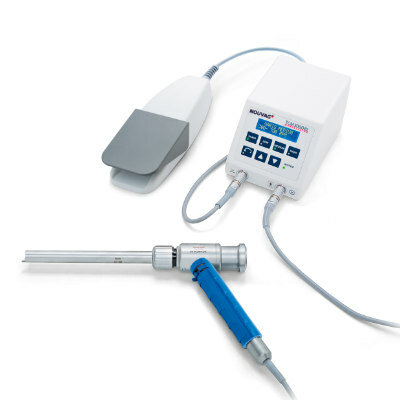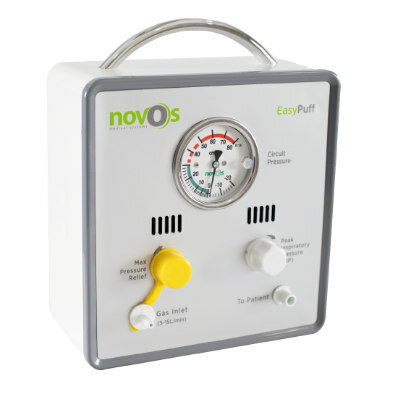Novel Suturing Device Facilitates Soft Tissue Closure 
|
By HospiMedica International staff writers Posted on 25 Nov 2015 |

Image: The Lariat suture delivery device and polyester braid (Photo courtesy of SentreHEART).
A new delivery device provides an intuitive solution to soft tissue closure compatible with a wide range of surgical procedures.
The Lariat suture delivery device is intended for use in surgical applications where soft tissues need to be approximated and ligated. It is based on a pre-tied, common polyester suture loop to provide complete closure with no metal, clip, or implant left behind. The user-controlled remote delivery system can deliver the 40-mm suture loop through an access of 4.3 mm or greater, and is compatible with a wide range of anatomical shapes. One of the primary indications is for ligating the left atrial appendage (LAA) to treat atrial fibrillation (AF).
The collapsible snare retains the suture loop until ready to deploy, opening or closing it as needed to confirm placement prior to suture release. Once in position, the Meltzer knot is tightened with the Tensure integrated suture-tightening system, reducing the risk of operator variability during closure. The low profile design also gives surgeons greater control in suture placement, and is designed to be compatible with open- chest, thoracotomy, or port access procedures. The Lariat suture delivery device is a product of SentreHEART (Redwood City, CA, USA), and has received the European community CE marking of approval.
“The Lariat surgical device solves many of the issues posed by current closure technologies in surgery,” said Russell Seiber, president and CEO of SentreHEART. “Improving the surgeon's control, reducing operator variability, and minimizing technique dependence through a simple to deliver, repeatable, suture-based solution is more natural for cardiac surgeons and should lead to better outcomes.”
“The Lariat surgical device is an elegant surgical closure solution, combining the best of all the current approaches into a single device,” said associate professor of cardiac surgery Krzysztof Bartus MD, PhD, of Jagiellonian University (Krakow, Poland). “The new device enables flexibility in my approach and access to close tissue where I want, with the additional confidence that it will remain closed. These are important characteristics when closing soft tissue such as the LLA.”
The LAA is a small, ear-shaped sac in the muscle wall of the left atrium. In normal hearts, the heart contracts with each heartbeat, and the blood in the left atrium and LAA is squeezed out into the left ventricle. When a patient has AF, the chaotic impulses do not give the atria time to contract, and blood collects and can form clots in the LAA and atria. The LAA is thought to be the source of more than 90% of stroke-causing blood clots that come from the heart in non-valvular AF patients.
Related Links:
SentreHEART
The Lariat suture delivery device is intended for use in surgical applications where soft tissues need to be approximated and ligated. It is based on a pre-tied, common polyester suture loop to provide complete closure with no metal, clip, or implant left behind. The user-controlled remote delivery system can deliver the 40-mm suture loop through an access of 4.3 mm or greater, and is compatible with a wide range of anatomical shapes. One of the primary indications is for ligating the left atrial appendage (LAA) to treat atrial fibrillation (AF).
The collapsible snare retains the suture loop until ready to deploy, opening or closing it as needed to confirm placement prior to suture release. Once in position, the Meltzer knot is tightened with the Tensure integrated suture-tightening system, reducing the risk of operator variability during closure. The low profile design also gives surgeons greater control in suture placement, and is designed to be compatible with open- chest, thoracotomy, or port access procedures. The Lariat suture delivery device is a product of SentreHEART (Redwood City, CA, USA), and has received the European community CE marking of approval.
“The Lariat surgical device solves many of the issues posed by current closure technologies in surgery,” said Russell Seiber, president and CEO of SentreHEART. “Improving the surgeon's control, reducing operator variability, and minimizing technique dependence through a simple to deliver, repeatable, suture-based solution is more natural for cardiac surgeons and should lead to better outcomes.”
“The Lariat surgical device is an elegant surgical closure solution, combining the best of all the current approaches into a single device,” said associate professor of cardiac surgery Krzysztof Bartus MD, PhD, of Jagiellonian University (Krakow, Poland). “The new device enables flexibility in my approach and access to close tissue where I want, with the additional confidence that it will remain closed. These are important characteristics when closing soft tissue such as the LLA.”
The LAA is a small, ear-shaped sac in the muscle wall of the left atrium. In normal hearts, the heart contracts with each heartbeat, and the blood in the left atrium and LAA is squeezed out into the left ventricle. When a patient has AF, the chaotic impulses do not give the atria time to contract, and blood collects and can form clots in the LAA and atria. The LAA is thought to be the source of more than 90% of stroke-causing blood clots that come from the heart in non-valvular AF patients.
Related Links:
SentreHEART
Latest Surgical Techniques News
- Hydrogel-Based Miniaturized Electric Generators to Power Biomedical Devices
- Custom 3D-Printed Orthopedic Implants Transform Joint Replacement Surgery
- Wearable Technology Monitors and Analyzes Surgeons' Posture during Long Surgical Procedures
- Cutting-Edge Imaging Platform Detects Residual Breast Cancer Missed During Lumpectomy Surgery
- Computational Models Predict Heart Valve Leakage in Children
- Breakthrough Device Enables Clear and Real-Time Visual Guidance for Effective Cardiovascular Interventions
- World’s First Microscopic Probe to Revolutionize Early Cancer Diagnosis
- World’s Smallest Implantable Brain Stimulator Demonstrated in Human Patient

- Robotically Assisted Lung Transplants Could Soon Become a Reality
- AI to Provide Heart Transplant Surgeons with New Decision-Making Data
- New Surgical Tool Empowers Precision and Confidence in Operating Room
- Future Muscle-Powered Surgical Robots Could Perform Minimally Invasive Procedures inside Body
- Non-Invasive Technique Combines Cardiac CT with AI-Powered Blood Flow for Heart Bypass Surgery
- First-Of-Its-Kind Device Repairs Leaky Tricuspid Heart Valve
- New Signaling Method Enables Precise Localization of Miniature Robots and Surgical Instruments inside Body
- Novel Catheter System Enables Safer, More Cost-Effective Transseptal Procedures
Channels
Artificial Intelligence
view channel
AI-Powered Algorithm to Revolutionize Detection of Atrial Fibrillation
Atrial fibrillation (AFib), a condition characterized by an irregular and often rapid heart rate, is linked to increased risks of stroke and heart failure. This is because the irregular heartbeat in AFib... Read more
AI Diagnostic Tool Accurately Detects Valvular Disorders Often Missed by Doctors
Doctors generally use stethoscopes to listen for the characteristic lub-dub sounds made by heart valves opening and closing. They also listen for less prominent sounds that indicate problems with these valves.... Read moreCritical Care
view channel
Deep-Learning Model Predicts Arrhythmia 30 Minutes before Onset
Atrial fibrillation, the most common type of cardiac arrhythmia worldwide, affected approximately 59 million people in 2019. Characterized by an irregular and often rapid heart rate, atrial fibrillation... Read more
Breakthrough Technology Combines Detection and Treatment of Nerve-Related Disorders in Single Procedure
The peripheral nervous system (PNS) serves as the communication network that links the brain and spinal cord to every other part of the body. It consists of two parts: the somatic nervous system, which... Read morePatient Care
view channel
Surgical Capacity Optimization Solution Helps Hospitals Boost OR Utilization
An innovative solution has the capability to transform surgical capacity utilization by targeting the root cause of surgical block time inefficiencies. Fujitsu Limited’s (Tokyo, Japan) Surgical Capacity... Read more
Game-Changing Innovation in Surgical Instrument Sterilization Significantly Improves OR Throughput
A groundbreaking innovation enables hospitals to significantly improve instrument processing time and throughput in operating rooms (ORs) and sterile processing departments. Turbett Surgical, Inc.... Read more
Next Gen ICU Bed to Help Address Complex Critical Care Needs
As the critical care environment becomes increasingly demanding and complex due to evolving hospital needs, there is a pressing requirement for innovations that can facilitate patient recovery.... Read moreGroundbreaking AI-Powered UV-C Disinfection Technology Redefines Infection Control Landscape
Healthcare-associated infection (HCAI) is a widespread complication in healthcare management, posing a significant health risk due to its potential to increase patient morbidity and mortality, prolong... Read moreHealth IT
view channel
Machine Learning Model Improves Mortality Risk Prediction for Cardiac Surgery Patients
Machine learning algorithms have been deployed to create predictive models in various medical fields, with some demonstrating improved outcomes compared to their standard-of-care counterparts.... Read more
Strategic Collaboration to Develop and Integrate Generative AI into Healthcare
Top industry experts have underscored the immediate requirement for healthcare systems and hospitals to respond to severe cost and margin pressures. Close to half of U.S. hospitals ended 2022 in the red... Read more
AI-Enabled Operating Rooms Solution Helps Hospitals Maximize Utilization and Unlock Capacity
For healthcare organizations, optimizing operating room (OR) utilization during prime time hours is a complex challenge. Surgeons and clinics face difficulties in finding available slots for booking cases,... Read more
AI Predicts Pancreatic Cancer Three Years before Diagnosis from Patients’ Medical Records
Screening for common cancers like breast, cervix, and prostate cancer relies on relatively simple and highly effective techniques, such as mammograms, Pap smears, and blood tests. These methods have revolutionized... Read morePoint of Care
view channel
Critical Bleeding Management System to Help Hospitals Further Standardize Viscoelastic Testing
Surgical procedures are often accompanied by significant blood loss and the subsequent high likelihood of the need for allogeneic blood transfusions. These transfusions, while critical, are linked to various... Read more
Point of Care HIV Test Enables Early Infection Diagnosis for Infants
Early diagnosis and initiation of treatment are crucial for the survival of infants infected with HIV (human immunodeficiency virus). Without treatment, approximately 50% of infants who acquire HIV during... Read more
Whole Blood Rapid Test Aids Assessment of Concussion at Patient's Bedside
In the United States annually, approximately five million individuals seek emergency department care for traumatic brain injuries (TBIs), yet over half of those suspecting a concussion may never get it checked.... Read more
New Generation Glucose Hospital Meter System Ensures Accurate, Interference-Free and Safe Use
A new generation glucose hospital meter system now comes with several features that make hospital glucose testing easier and more secure while continuing to offer accuracy, freedom from interference, and... Read moreBusiness
view channel
Johnson & Johnson Acquires Cardiovascular Medical Device Company Shockwave Medical
Johnson & Johnson (New Brunswick, N.J., USA) and Shockwave Medical (Santa Clara, CA, USA) have entered into a definitive agreement under which Johnson & Johnson will acquire all of Shockwave’s... Read more
















